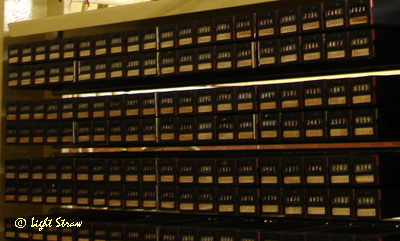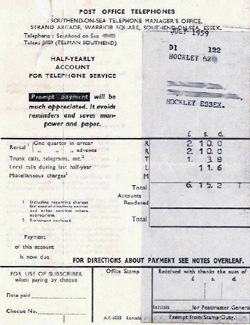Subscribers' Meters
Subscribers meters were originally 4-digit counters. However, with
the onset of multi-fee metering and businesses making more use of the
telephone, it was not unknown for the meter to go past 9999 more than
once during a quarter, so 5-digit counters were specified for new racks.
In some older exchanges, rather than replace a whole strip of meters,
only those of selected lines were changed out.
 |
The meters were mounted on a meter-plate holding 100 meters,
5 rows of 20. Later fixings were simplified to 2 rows of 20.
The Subs. telephone number was printed on a small white card
slipped underneath the window of the meter. Exceptionally,
6-digit meters were later fitted to high calling rate lines
(e.g. customers frequently calling abroad and some
businesses).
Photo: Meter strips of 2 x 20 in the Light Straw ATE © LSA
2008.
|
| |
|
In 1961, three types of meter were in use:
- The large No.1 type
- The smaller No.100 type
- The No.150
|
Meter Reading Processes
1 - Manual
- Visual reading and entering in meter book.
- Meter book taken
to T.M.s Office.
- Subtraction using office machine.
- Monetary
equivalent obtained from ready reckoner.
- Account printed by
adding / listing machine.
|
| Meter |
Book taken to office |
Meter
Book |
Calculation |
Account |
| Exchange |
Telephone Manager's
Office |
|
| |
|
2 - Punched Card
- Visual reading and entering on schedule.
- Schedule taken to T.M.s Office.
- Punched card prepared by hand.
- Account prepared and printed by automatic
machinery.
|
| Meter |
Schedule taken to office |
Key Punch |
Main Accounting Machinery |
Account |
| Exchange |
Telephone Manager's
Office |
|
| |
|
3 - Photography & Punched Card
- Meters photographed on site.
- Negative taken to T.M.s Office.
- Photographs prepared for display.
- Photographs automatically presented in order, card
punched by hand.
- Account prepared and printed by automatic machinery.
|
| Meter |
Negatives taken to office |
Photo
Processing |
Photo
Reader |
Key Punch |
Main Accounting Machinery |
Account |
| Exchange |
Telephone Manager's
Office |
|
| |
|
4 - Telephone Billing TB3 and TB5
- In 1968, the first fully computerised Telephone Billing
(TB3) system was introduced into T.M.Os.
- This evolved into Telephone Billing stage 5 (TB5).
- The TB systems involved the processing of accounts being
carried out at a Computer Centre, remote from the T.M.O.
which had far less control over the process than with the
earlier mechanical aids programmes.
- Meter Reading information was prepared on Keyforms which
were sent to a Data Conversion Centre which in turn produced
punched cards for input to the billing system.
|
| |
5 - Telecommunications On Line Data (TOLD)
- Meters photographed on site.
- Developed film sent to TAO.
- Photographs prepared for display.
- Readings input via keyboard to TOLD.
- Account calculated and bill produced by computer
centre.
|
| Meter |
Developed Film taken to office |
Photo
Reader |
Manual keying to TOLD |
Data Collection |
Bill Production |
Account |
| Exchange |
Telephone Manager's
Office |
Computer Centres |
|
| |
|
In the mid-Seventies, remote mainframe computer access was introduced
into the TAOs (Telephone Area Offices). The meters were photographed and
the developed film sent to the Area Office where the readings were
displayed on a viewer. The TAG CA (Territorial Accounts Group Clerical
Assistant) was responsible for keying the values into the 'Cossor'™ VDU
via the TOLD terminal.
|

